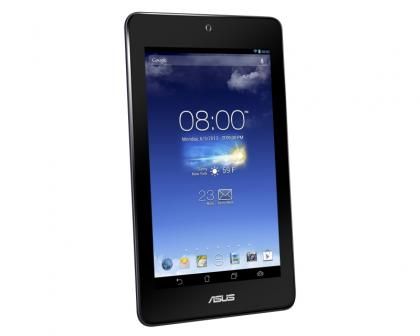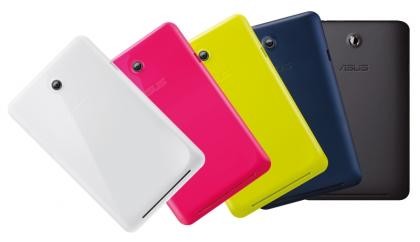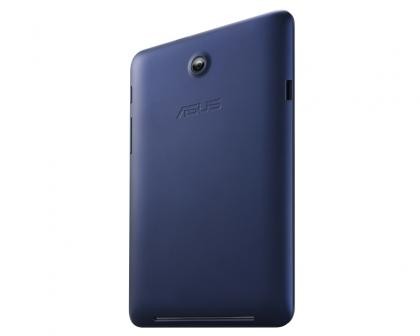If there's one company that knows how to make a great budget tablet, it's Asus. Having cut its teeth manufacturing the Nexus 7 for Google then following it up with a slew of Intel-powered devices such as the FonePad, it’s now looking to lower the price of entry even further with the Memo Pad HD 7.

With its 7in widescreen display and black screen bezel, you could easily mistake the Memo Pad HD 7 for a Nexus device. From the back, however, the vibrant colours and glossy finish make it clear this is something very different. At 302g and with a slightly shorter bezel, the HD 7 is both smaller and lighter than the Nexus, and you get a choice of five colours too. The plastic rear panel doesn’t feel as pleasant as the rubberised panel on the Nexus, and it shows a little bit of flex, but it keeps the price down and doesn't make it any less comfortable to use. The volume and power buttons are recessed slightly at the right side of the tablet, but you quickly get used to reaching further behind in order to use them.

It's available in a range of bright colours
HAPPY RESOLUTION
The 7in IPS panel is impressive, and its brightness and contrast is similar to that of the Nexus 7. Viewing angles are excellent and colour accuracy is superb. The Asus Splendid app lets you decrease or increase the vibrancy to suit your personal taste. This is a welcome change from the norm, as many budget tablets use TN panels with poor viewing angles or have a grainy screen finish.
The 1,280x800 resolution might seem a little low now that 1,920x1,080 resolutions are increasingly common, but pictures and text still looked crisp. Of course, you can still watch native 720p video on the tablet, and it downscales Full HD video. However, the glossy finish can make light reflections a problem, so movies are best enjoyed away from any windows or overhead lights. The stereo speakers are a good match to the screen, and are comfortably loud with reasonable sound quality.
MEDIA POWER
The Memopad HD 7 is powered by a 1.2GHz MediaTek processor with four cores, and it’s more than capable of running Android 4.2 smoothly. There's an occasional bit of lag when switching from portrait to landscape orientation, or swiping rapidly between home screens filled with widgets, but it mostly felt snappy and responsive.
We expected the quad-core processor to be power hungry, but the Memo Pad HD 7 surprised us with a superb result in our light use battery test. Lasting 10 hours 59 minutes on a single charge, it outlasted the 2012 Nexus 7 by almost 40 minutes. Unless you're constantly playing 3D games, you it’ll last a full day of use.
Its PowerVR graphics processor is mostly good. 2D games such as Angry Birds are no challenge, and most 3D games play smoothly, with only the most demanding games such as Real Racing 3 stuttering slightly. Even so, we could still finish races without major complaints.

Many entry-level tablets suffer poor performance due to rendering custom Android interfaces. Asus has avoided this pitfall, with only minor tweaks to the default Android interface. The pull-down notification drawer has a vibrant purple skin, and there's a fourth icon on the navigation bar that can open a set of floating mini apps. These can be displayed over the top of any full screen app, which is great if you need to access a calculator, notepad or small web browser quickly but don't want to leave a particular screen.
There are plenty of preinstalled apps, but not all of them will prove useful if you've invested in apps to handle your media already. You get the Amazon Kindle and MyLibrary apps, which may not be useful if you already use Google Play Books. My BitCast, SuperNote Lite and Asus To-Do let you create notes and lists, Asus Artist lets you draw sketches and Asus Story and Asus Studio store photos for presentation.
It has 16GB of internal storage for apps and files, which is fairly standard, but it's great to see a MicroSD card slot and you'll be able to add an extra 32GB to the HD 7 if you run out of space.
Despite running Android version 4.2, Asus has disabled the multiple user accounts feature in favour of its own Parental Lock app. It lets you limit the tablet as you see fit, and track the device over the web.

DISPOSABLE CAMERA?
Asus has also tweaked the stock Camera app with its own interface, putting the shutter, zoom and video record buttons at the bottom edge of the screen for one-handed use. Camera modes such as panorama and High Dynamic Range (HDR) are present, along with a set of Instagram-like filters. A 1.2-megapixel front-facing camera is to be expected from a budget tablet, but Asus has somehow managed to squeeze in a 5-megapixel, f/2.4 rear camera into the Memo Pad HD 7 as well, so photos are of reasonable quality.
Outdoor shots sometimes had overexposed skies, but colour accuracy is pretty good and there's a decent amount of detail in the foreground. It has Tap to Focus, which gives you greater control than many budget tablets, but unless lighting conditions are perfect many pictures end up with a slight blue hue as a result of inaccurate white balancing. With the camera lens located so close to the top edge of the tablet, it's all too easy to obscure photos with your fingers when holding the Memo Pad HD 7 in landscape.
Moving indoors, our still life setup shows that low-light shooting isn't really an option with the HD 7, as it struggles to focus, loses lots of detail and produces very noisy shots. With more light, it can achieve reasonably sharp shots, but it still lacks detail compared to most smartphones.
You can record video at a resolution of 1,920x1,080, and in good light it can produce reasonable results if you hold the tablet steady. Adding motion doesn't help matters, with the autofocus often struggling to keep up, and low light conditions experience similar issues with noise and loss of detail as when shooting stills.
CONCLUSION
It was August 2013 when Asus, the manufacturer of the excellent Google-branded Nexus 7 produced this also excellent budget device for those who didn't want to spend any more than necessary on a small Android tablet. We gave it a Budget Buy award at the time, but is it still a good buy now?
You can buy the tablet for £108 inc delivery today from a reputable Amazon Reseller . That's still cheaper than most of the small tablets, even the basic Tesco Hudl costs £12 more. The Memopad has a good IPS-technology 1,280x800 resolution display and a quad-core processor that copes admirably with day-to-day tasks but struggles with 3D graphics.
For the money it remains one of the best cheap tablets around then. However, If you're willing to spend a bit more you can get the far quicker Advent Vega Tegra Note for £140 from PC World. However, for the money the Asus MemoPad HD 7 remains the best cheap tablet at this price.
|
Basic Specifications |
|
Rating |
***** |
|
Processor |
MTK 8125 |
|
Processor clock speed |
1.2GHz |
|
Memory |
1.00GB |
|
Memory slots |
1 |
|
Memory slots free |
0 |
|
Maximum memory |
1GB |
|
Size |
197x121x11mm |
|
Weight |
302g |
|
Sound |
N/A |
|
Pointing device |
Touchscreen |
|
Display |
|
Viewable size |
7 in |
|
Native resolution |
1,280x800 |
|
Graphics Processor |
PowerVR SGX 544 |
|
Graphics/video ports |
none |
|
Storage |
|
Total storage capacity |
16GB |
|
Optical drive type |
none |
|
Ports and Expansion |
|
Bluetooth |
yes |
|
Wired network ports |
none |
|
Wireless networking support |
802.11n |
|
PC Card slots |
none |
|
Supported memory cards |
MicroSDHC |
|
Other ports |
3.5mm audio output |
|
Miscellaneous |
|
Carrying case |
No |
|
Operating system |
Android 4.2 |
|
Operating system restore option |
restore partition |
|
Software included |
none |
|
Optional extras |
none |
|
Buying Information |
|
Warranty |
one year RTB |
|
Price |
£130 |
|
Details |
www.asus.com |
|
Supplier |
http://www.dixons.co.uk |